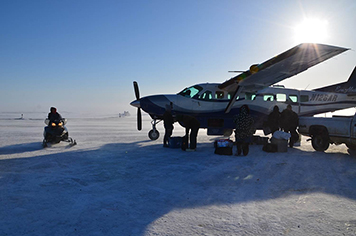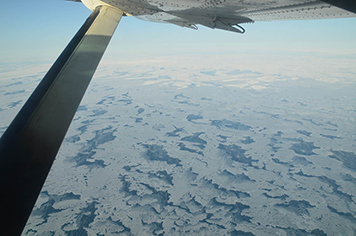NOAA and Private Industry Share Data to Improve Our Understanding of the Arctic
MARCH 17, 2014 -- Gathering data and information about Arctic air, lands, and waters is critical to NOAA's missions. We work to protect coastal communities and ensure safe navigation, healthy oceans, effective emergency response, and accurate weather forecasting. But we need to be able to access remote areas of land and ocean to get that information in the first place. The expansive, harsh Arctic environment can make this access risky, expensive, and at times impossible. The U.S. Arctic is a unique ecosystem that requires unique solutions for solving problems. To continue improving our understanding of the Arctic, NOAA must seek innovative ways to gather essential data about the climate, ocean, and living things in this part of our world.

The Rules of Sharing
We recognize that no single agency or organization has enough resources to do this alone. We have to collaborate our research efforts and share data with others working in the Arctic. An innovative agreement between NOAA and industry [PDF] was signed in August 2011 to help identify and pursue data needs in the Arctic. This agreement between NOAA, Shell, ConocoPhilips, and Stat Oil sets up a framework for sharing Arctic data in five areas:
- meteorology.
- coastal and ocean currents, circulation, and waves.
- sea ice studies.
- biological science.
- hydrographic services and mapping.
Before we incorporate this data into NOAA products and services, we will conduct stringent quality control on all data provided to us under this agreement. Having access to additional high-quality data will improve NOAA’s ability to monitor climate change and provide useful products and services that inform responsible energy exploration activities in the region. We are committed to openness and transparency in our science. In addition to reviews to ensure the quality of the data that we receive, NOAA will make the data obtained under this agreement available to the public. Exactly what data is shared and how it is shared is laid out in a series of annexes to the overarching agreement. NOAA and the three companies have identified the need for at least three annexes. The first [PDF] and second [PDF] are complete. The third, which covers hydrographic services and mapping, is being drafted now.

Why Sharing (Data) Is Caring

This collaboration will leverage NOAA's scientific expertise and these companies' significant offshore experience, science initiatives, and expertise. By establishing this data-sharing agreement and the associated annex agreements, NOAA is better equipped to protect the Arctic's fragile ecosystem. We will be providing the public—including energy companies, mariners, native communities, fishers, and other government agencies—with a stronger scientific foundation, which we believe will better support decision making and safe economic opportunities in this rapidly changing area. NOAA envisions an Arctic where decisions and actions related to conservation, management, and resource use are based on sound science and support healthy, productive, and resilient communities and ecosystems. We are working hard, in an era of shrinking budgets, to make sure that we are good stewards of the natural resources found in the Arctic. We will hold our industry partners to our high standards, and make sure that as we learn more, we also prepare for and minimize the risks involved in Arctic oil and gas development and increased maritime transportation. We look forward to working with these industry partners to implement this data-sharing agreement. This agreement is the type of innovative partnership we'd like to build with other entities willing to share data and work with us—leveraging the best of what we each can bring to the table. Learn more about the work NOAA’s Office of Response and Restoration is doing in the Arctic.
